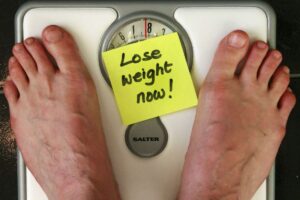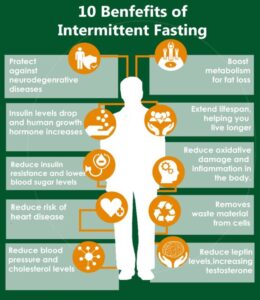Dr. Trishala Chopra is an alternative medicine specialist commanding a decade of success in managing Diabetes, Obesity, PCOD/PCOS, Metabolic Disorders, Gut-health and Sleep-disorders. As a Health Coach, Dr. Trishala empowers your body’s potential to heal itself through a balanced ‘Gut-Mind-Body’ approach to help you achieve your wellness goals. [To connect with Dr. Trishala, Call/Message: (+91) 9930831317 or Email ID: drtrishalachopra@gmail.com]
 In keeping with the innumerable calls and mails sent to me by our readers about Intermittent Fasting, this week’s article is dedicated to further demystifying aspects of Intermittent Fasting (IF).
In keeping with the innumerable calls and mails sent to me by our readers about Intermittent Fasting, this week’s article is dedicated to further demystifying aspects of Intermittent Fasting (IF).
IF is becoming increasingly popular in recent times because this is one of the simplest ways to lose weight and achieve better health. To answer your questions about fasting, here is a basic guide which helps you get started with IF.
I’ve personally been fasting for over 3 years now. I stay with 2 meals a day. My eating window lasts for 8 hours and I fast for the remaining 16 hours. Surprisingly, since I started fasting, my muscle mass increased and my fat percentage reduced – without having to live in the gym for the rest of the day! I lost a significant amount of weight but I have gained health. In short, I am now stronger, leaner and happier!
 As a Doctor, it was easy for me to incorporate fasting in my life but I strongly recommend that this be done only with medical supervision, especially when you’re starting out. If fasting is not done in the correct manner, it can lead to serious health issues, which can be avoided if done under the supervision of a specialist.
As a Doctor, it was easy for me to incorporate fasting in my life but I strongly recommend that this be done only with medical supervision, especially when you’re starting out. If fasting is not done in the correct manner, it can lead to serious health issues, which can be avoided if done under the supervision of a specialist.
In most of my first consultations with people who tell me they are already following some pattern of IF, I get to hear, “It doesn’t seem to work for me.” They either feel weak, or seem to lose hair, fall sick more often, are very low on energy and the list goes on. How is this possible when fasting is supposed to improve health! Where are you going wrong? If fasting helps you lose weight, then how do some people end up actually gaining weight??
Additionally, I also get questions like, “Isn’t skipping breakfast harmful to your health – aren’t you supposed to be ‘eating breakfast like a king’?” Slow down, dear readers! As health professional, we help you fast your way to better health, with the least possible medicines! Let me break down IF further for you. You need to understand that fasting is a science – it will not work for you if you are not doing it right. This article provides a basic overview to IF, but each body is different and therefore, your fasting procedure needs to be customised for you by a professional, for you to get the results you seek.
INTERMITTENT FASTING…
Intermittent fasting is not a ‘diet’ – it’s an eating pattern – and a flexible one at that, where you get to decide how and when to do it.
How Does IF Help In Fat Loss?
To understand this, you first need to understand about the two states of Fasting:
- ‘The Fed State’: is the state in which your body digests and absorbs food. It starts when you begin eating and it lasts for 3-5 hours, as your body processes the food consumed. It’s hard for the body to burn (utilize) the fat because your insulin (hormone that triggers fat storage) levels are high.
- ‘The Fasted State’: follows the ‘Fed State’, where post meal consumption (after being in the fed state for a while), your body enters a phase where it isn’t processing a meal. About 8-12 hours after your last meal – is when you enter the fasted state. Your body burns fats much faster in the fasted state because your insulin levels are low.
If we look at our current eating schedule, it’s rare for most to go beyond 8-12 hours without eating anything, which means that we do not enter the ‘Fasted State’ in our daily life. This is why, when initially people start fasting even without changing much of what they eat, they still begin losing weight quickly.
The following are the basic IF Schedules that most are advised to begin with, under professional supervision:
(I) The Daily 16:8 Intermittent Fasting Schedule: This is the easiest way to incorporate fasting in your daily routine, without disturbing your lifestyle too much. You have an 8-Hour Feeding Window and a 16-Hour Fasting Window.
- You choose the timing that best suits you – so your eating window could be from 8:00am to 4:00pm or from 11:00am to 7:00pm or from 12:00pm to 8:00pm. This is very flexible, but you are advised to then stick with that chosen timing. Start with whatever works for you. Most of my patients feel skipping breakfast is easier, but lunch/dinner is part of their social events and hence they don’t have to skip events.
- The 16:8 IF schedule helps you get into a schedule similar to an eating schedule.
IMP NOTE: Since you cut out an entire meal, this impacts your intake of sufficient nutrition. It is absolutely crucial that you maintain your macronutrient and micronutrient targets during eating hours, in keeping with the needs of your body and health conditions, to get complete benefit.
(I) The Weekly Intermittent Fasting Schedule: is another way to get fasting into your routine by getting started with IF once a week. While Weekly IF is more difficult and doesn’t contribute much to weight loss, you still gain other benefits of fasting.
- You can start with doing a 24-hour fast, once a week. For example, if you finish having your dinner today at 8:00 pm, your next meal will be at 8:00 pm tomorrow. This fasting pattern works for those looking to maintain your current weight or maintaining good health.
I hope this article was helpful and helped answer some of your queries. Do call or email me your queries and I will look to answering these in our oncoming articles.
- બરોડાની કોન્ટ્રાક્ટર આદરિયાને 102માં સાલગ્રેહની ઉજવણી કરી - 8 March2025
- વિસ્પી ખરાડીએ નવો ગિનિસ વર્લ્ડ રેકોર્ડ બનાવ્યો - 8 March2025
- પારસી મહિલાઓનું સશક્તિકરણ:મહિલા દિવસનું મહત્વ - 8 March2025
